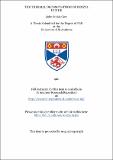The thermal decomposition of benzyl iodide
Abstract
The results of the work, described in this thesis, may be summarized as follows:- 1) The gas phase pyrolysis of benzyl iodide, either alone or in the presence of added free iodine, proceeds via the following mechanism
BzI ⟷Ke Bz + I
I + I ⟷ I ₂
Bz + Bz ⟶ k2 Bz-Bz
An analysis of the data has been carried out where reactions (a) and (b) are presumed to reach equilibrium and reaction (c) is rate determining. Over a temperature range of 516°K, carried out using both static (516-557°K) and flow (611-702°K) systems with benzyl iodide partial pressures from. 03 mm. to 9.0 mm., the logarithm of 2 k₂Ke² plotted against 1/(T°K) gave a straight line. The slope of this Line on the above mechanism is equal to (2 △h+E)/2.3R (where △ = change in heat content associated with the equilibrium BzI ⟷Bz + I and E = the activation energy of the reaction Bz + Bz ⟶ Bz-Bz) and (2 △H + E) was found to be 84 K cal./mol. On the assumption that E = O, this is equivalent to a benzyl iodide bond strength of 42 K cal./mol. This experimentally derived bond strength must be reduced by 1 K cal./mol. for every 2 K cal./mol. Of energy of activation required by the recombination of tow benzyl radicals. A review of the literature, on free radical recombination energies, suggests that for benzyl radicals it is not likely to exceed 4-5 L cal./mol. And therefore the present investigation leads to a value of 40-42 K cal./mol. for the strength of the carbon-iodine bond in benzyl iodide.
2) It has been shown that, in the presence of excess hydrogen iodide as a radical acceptor, benzyl iodide decomposes according to the following mechanism –
(a) BzI ⟶ Bz + I
(b) I + I ⟷I₂
(d) Bz + HI ⟶ Bz-H + I
(e) I + BzI ⟶ Bz + I₂
In this scheme, the rate determining process is the dissociation process in (a) since, with sufficient HI present, reaction (d) prevents an equilibrium concentration of benzyl radicals being built up. It has been shown to be possible to obtain conditions where the rate of iodine formation is independent of HI concentrations. Using such conditions, reaction epsilon was shown to be a very significant contributor to the total rate. Moreover, the elimination of the back reaction in (a) produced a large increase in decomposition rate, so much so that the range of temperature used in this section of the work was over 100oC below that for the previous section. The energy of activation of the reaction (e); has been determined as 4.1 K cal./mol. (This value was calculated from results covering the temperature range 505 to 585°K). Using Perlman and Rollefson's(78) data on the dissociation of molecular iodine, this activation energy of 4.1 K cal./mol. is equivalent to a benzyl iodide bond strength of 40.6 K cal./mol. This value is in good agreement with that obtained from the pyrolysis work in the absence of a radical acceptor. The initial dissociation reaction (Bzl ⟶ Bz + I) has been found to be between first and second order at the partial pressures of benzyl iodide used (0.02 mm. - 0.13 mm.) and this is attributed to the normal Hinshelwood-Lindemann effect for unimolecular reactions. An approximate value of 0.35 sec.⁻¹ for the high pressure limiting rate constant at 585°K has been deduced. This corresponds to an Arrhenius factor for the decomposition of 1014.6 sec.⁻¹, if the benzyl iodide bond strength is assumed to be 40.6 K cal./mol. 3) At the very lowest partial pressures used (~0.02 mm.), the initial dissociation reaction approaches second order behaviour and the temperature dependence of assumed second order rate constants leads to an activation energy of 40 K cal./mol. for the decomposition. The corresponding pre-exponential factor is 10 ²⁰.⁴, which is of the order of magnitude to be expected for a reaction of this type. The data, in this low pressure region, are, however, insufficient to establish that the reaction in accurately second order at these pressure. 4) If the bond strength of benzyl iodide is taken as 41 K cal./mol., as determined in this present investigation, a value may be calculated for the heat of formation of the benzyl radical. Using 27.2 K cal./mol. for the heat of benzyl iodide, as suggested by skinner(63), a value of 43 K cal./mol. is obtained for △Hf (benzyl). This is in close agreement with the values of 45.3 K cal./mol. and 44.8 cal./mol., obtained in this department by Alexander(58) and Davidson(59) respectively - their values were derived their determinations of the bond strength of the central carbon-carbon bond in dibenzyl. The present value of 43 L cal./mol. is also in accord with the 44.9 K cal./mol., deduced from Benson and buss(47) determination of the toluene bond strength as 84 K cal./mol. The more commonly quoted toluene bond strength of 77.5 K cal./mol., obtained by Szwarc(48) leads to a △Hf (Benzyl) of only 37.4 K cal./mol. and would, therefore, seem to be too low.
Type
Thesis, PhD Doctor of Philosophy
Collections
Items in the St Andrews Research Repository are protected by copyright, with all rights reserved, unless otherwise indicated.

